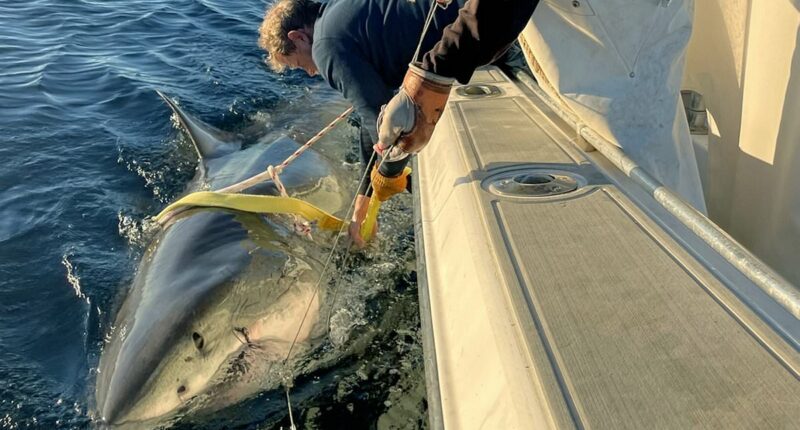Share this @internewscast.com
The biggest great white shark ever recorded in the Atlantic has resurfaced just off the coast of Canada.
In January, OCEARCH, a non-profit organization dedicated to studying large marine animals, tagged a 14-foot shark named Contender 45 miles off the coast of Florida and Georgia in the North Atlantic.
The shark’s tracker only transmits a locating signal when its back fin is exposed above the water’s surface.
Last week the tracker ‘pinged’ from the far northern reaches of the Gulf of St. Lawrence, off the Labrador Peninsula in Canada.
Researchers said this made Contender ‘one of the furthest northern pinging sharks that we’ve had’.
The 1,653lbs shark, estimated to be around 30 years old, is in the area gorging on seals to build fat for his return to Florida in winter.
Scientists at OCEARCH hope tracking Contender will reveal the world’s first known great white shark mating site.
Chris Fischer founder and expedition leader of OCEARCH, said: ‘Only a couple have made it that far north.

The biggest great white shark ever recorded in the Atlantic has resurfaced just off the coast of Canada

The 14ft shark, named Contender, and was tagged 45 miles off the Florida-Georgia coast in the North Atlantic by OCEARCH in January – a non-profit that researches large marine animals
‘An animal like that, spending the summer and fall up north – what are they doing? Well, a lot of what they’re doing is preparing for the winter.’
Fischer said that Contender is ‘putting a lot of pressure on the seals, eating seals constantly, swimming in front of seal colonies, trying to put on some weight before he proceeds back down to Florida for the oncoming winter’.
And he says this behavior has an unexpected environmental benefit.
‘The byproduct of putting that pressure on the seals is really good, they’re guarding our fish stocks,’ Fischer said.
‘We know that if the white sharks are in front of the seals putting pressure on them, they eat one-fourth as much per day.’
He added: ‘If that white shark’s not there, those seals go out and they wipe out all the fish.’
Contender’s presence in such cold northern waters demonstrates the remarkable adaptability of great whites, he said.
‘White sharks have the capacity to warm themselves and be in cold water, but they have to have a lot of food.
‘Like horses in winter – as long as they have food, they’re fine. If they run out of food, they freeze very quickly.’

The 1,653lbs shark, estimated to be around 30 years old, is in the area gorging on seals to build fat for his return to Florida in winter
Contender’s tracker ‘pinged’ when he surfaced off Natashquan, Canada, on September 29.
There was a z-ping – when the shark spends only a brief period of time at the surface but not enough to determine an accurate location – on October 2.
Tagged off the Florida-Georgia coast in January, Contender represents hope for a recovering population that was decimated decades ago.
‘We wiped out the sharks so badly in the seventies, eighties, and sixties – we got down to nine percent of our population,’ Fischer said.
What makes Contender particularly valuable to researchers is his potential to unlock one of marine biology’s greatest mysteries.
‘These big mature males are hugely important because they can help us understand where and when mating is occurring,’ Fischer said.
Unlike females, which have complex two-year migratory cycles, ‘the male white sharks basically have their whole year revolve around mating,’ he added.
The tracking data from Contender’s satellite tag, which will function for five years, could lead to an unprecedented scientific breakthrough.

Tagged off the Florida-Georgia coast in January, Contender represents hope for a recovering population that was decimated decades ago
‘There’s never been a white shark mating site identified anywhere in the world in any one of the nine populations,’ Fischer said. ‘It would be a first.’
Fischer’s team is particularly focused on Contender’s movements in the coming months.
The shark’s location next spring could provide crucial evidence for identifying mating grounds, with early data suggesting activity off the southeastern United States.
Despite his formidable size, Contender still has room to grow – possibly over 20 feet in total.
Fischer particularly interested to see what Contender will look like ’30 or 40 years from now,’ noting the mammoth animal is around 30 to 35 years old and can live to be over 70.
‘It’ll be really interesting to watch Contender this year,’ Fischer said.
‘I want to know where Contender will be in March of 2026, in April of 2026. I think that could be a massive clue for identifying where they mate.’








